September, 2014
now browsing by month
Language Village Movie Night “Heathers”
I had a movie night with my roommate Kim. We watched the movie “Heathers” for two nights. It was a very strange and disturbing movie. The movie was on Netflix. There was some connections to linguistics. Some of the phrases were different from the the phrases we use now. The slang was like ” totally”, “awesome” , “rad”, or phrases like “your such a brownie”. The slang today does not really use these phrases anymore. The movie manipulated the English language in order to make their own know language. For example, the cool, popular high school girls were called Heathers. The film makers changed idea of cliques with calling a girl a heather because it is a title of fame in the film. Some of sentences were like “fuck me gently with a chainsaw” which is basically trying to communicate that the character is offended or insulted. Another word “Salutations” is like a greeting but the character said it sarcastically. The language used in this film made a statement about the cool, popular kids that were given the opportunity to be called something else then every other high school student. It is a statement made to show that people in high school outcast other people that are not considered cool or popular. Overall, the movie was interesting. Even though, the guy almost killed everyone.
Language Village Film “Heathers”
Me and Paula had a 2 day movie night and watched Heather’s on Netflix. It was a very strange film, and we saw a few connections to Linguistics. First we noticed that they used a lot of language that we do not use much today such as “Salutations” when saying hello to someone or “fuck me gently with a chainsaw” when referring to being offended by another person. As we watched the film we also saw one of the actors compare two styles of saying “tomato”. They also used “awesome” and “cool” and “totally” more than we hear on average today. The film tends to use English in their own purpose and sense. For example, being called a “heather” at Western berg high school was the coolest thing to be named. They changed an average named to signify something of their own in the film. This film refers back to linguistics because we have spoken how English is an extremely complicated language because people use it in their own sense and you can make sense of phrases in so many different ways. The language in this film also makes a statement that the type of language you use defines whether you are cool and popular or not. There were names given to the unpopular fat, nerdy, or out of the circle kids and the “popular” kids were talked to differently and referred to differently as well. even though the movie was a litttleeee creepy, it was a good entertaining movie!
Review 1 – Collaborate!
(1) Five Terms I Definitely Know
(2) Four Terms I Know But Can’t Always Remember
(3) Three Terms I Don’t Understand
(a) Three Things I Know About Language & Linguistics in General
(b) Three Things I Know About Phonetics & Phonology
(c) Three Things I Know About Morphology
(d) Three Things I Know About Syntax
(e) Three Things I Know About Semantics
(f) Three Things I Know About the Philosophy of Language / Linguistic Theory
********
Class, try to answer each category above. Post your response as a Comment on this post OR as a comment to another person’s comment (be aware of what people before you have said). Try to answer your classmates’ responses to #3 especially. This review will guide you in taking Test One. Participation in this review counts towards your final grade.
Weekend Reminders for POS Wizards
Hello Apprentices of Linguistic Wizardy!
A few reminders for the weekend…
First, remember next week has updated office hours (in my office and on virtual chat):
Monday, 29-September: 10:30am-12noon
Thursday, 2-October: 4pm-5:30pm
Second reminder: Quizzes 7, 8, 9 are back online. Don’t forget to take them when you have a chance.
Third reminder: You need to create a Google Doc for your group to collaborate on what’s going in Blog-2. Here’s a video explaining how to create a Google Doc if you’re not sure: http://www.youtube.com/watch?v=EKt3-fruLyE
Make sure to send me the link to your Google Doc this weekend.
Finally, think about language this weekend… think about words not as single items, but as… things in need of other things. In order to build a sentence, we need a subject and a predicate. At their most basic, a Subject is a Noun Phrase consisting of the single Noun head and a predicate is a single Verb Phrase consisting of a single Verb head: Miranda sighed. But not all verbs work that way– *Miranda gave is not a normal grammatically acceptable sentence in English. That’s because different verbs have different Thematic Roles they can or must give out. Likewise, when the noun is rock (as in, any plain old rock you find on the side of a mountain), then you can’t have a sentence like *rock sighs. Not only does sighs need to give out a kind of thematic role that rock can’t fulfill, but also, rock is the kind of noun that needs something else in its Noun Phrase (like a determiner, as in The rock rolled down the mountain.).
The people at the Penn Tree Bank have been thinking about this for years. Have a look at how they categorize words and parts of speech and see if you agree or disagree with them. For possible extra credit, Microblog about Penn’s POS-tagging schema on the Language Village Tumblr– or write a full blog post about it on the course website. And take care with your formatting!
Have a great weekend!
-doug
The Language Hunt
 We thought we’d start of this oh so lovely scavenger hunt with a little trek out to the International Student Center. Isn’t that fun? That wall is so welcoming it decided to tell you in almost any language you could imagine. In all honesty though, it is an amazing wall that shows a lot of cultural diversity.
We thought we’d start of this oh so lovely scavenger hunt with a little trek out to the International Student Center. Isn’t that fun? That wall is so welcoming it decided to tell you in almost any language you could imagine. In all honesty though, it is an amazing wall that shows a lot of cultural diversity.
 I don’t think it was exactly after that (partially because these pictures definitely aren’t in order) , but we decided to stop by the financial aid office. We definitely need to make sure we know all about that, now don’t we?
I don’t think it was exactly after that (partially because these pictures definitely aren’t in order) , but we decided to stop by the financial aid office. We definitely need to make sure we know all about that, now don’t we?
 Next stop, Office of the Registrar. Let me ask you something. What exactly is a registrar anyways? I didn’t even know that word existed until I got to this school, but that might just be me.
Next stop, Office of the Registrar. Let me ask you something. What exactly is a registrar anyways? I didn’t even know that word existed until I got to this school, but that might just be me.
 Unfortunately, you can’t really read the sign since it’s on a glass door and as we all know glass doors are see through, but it says SDSU Library & Information Access. This building is actually super cool and has a lot of books in, you guessed it, other languages.
Unfortunately, you can’t really read the sign since it’s on a glass door and as we all know glass doors are see through, but it says SDSU Library & Information Access. This building is actually super cool and has a lot of books in, you guessed it, other languages.
 There were a couple people strutting it out in our picture, but it was no biggie. it gives the picture some character don’t you think? This is another image of the library just in case you didn’t get the picture from the last one.
There were a couple people strutting it out in our picture, but it was no biggie. it gives the picture some character don’t you think? This is another image of the library just in case you didn’t get the picture from the last one.
 That’s right, we have rights. We also have responsibilities but we don’t talk about those. Here is yet another sign we found in the public area that is our campus. Isn’t it just beautiful? Look at that font, and wow, that black on white contrast is amazing.
That’s right, we have rights. We also have responsibilities but we don’t talk about those. Here is yet another sign we found in the public area that is our campus. Isn’t it just beautiful? Look at that font, and wow, that black on white contrast is amazing.
Kaitlyn DeJesus
Laura Kalmanson
In Search of Culture
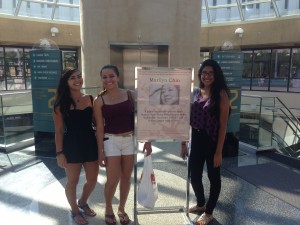 We started out our adventure quite excited in the Love Library in search of a poster in English.
We started out our adventure quite excited in the Love Library in search of a poster in English.
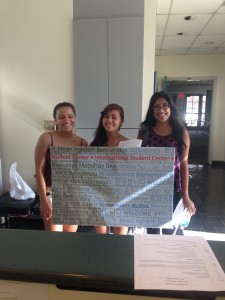 Next, we made our way to the International Student Center where we found a poster with every language EXCEPT Russian. There we met nice people and got help from a guy with broad shoulders. This was the beginning of deception. (He gave us wrong directions to the Cross Cultural Center, so we ventured all the way to Chappy to only find out it was now at the Union -__-)
Next, we made our way to the International Student Center where we found a poster with every language EXCEPT Russian. There we met nice people and got help from a guy with broad shoulders. This was the beginning of deception. (He gave us wrong directions to the Cross Cultural Center, so we ventured all the way to Chappy to only find out it was now at the Union -__-)
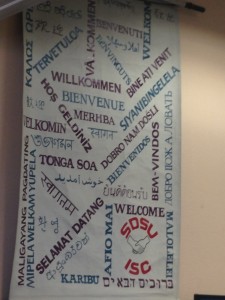 Before we left, we found a poster with Russian on it. We had to play eye spy to find and make sure that language was on there.
Before we left, we found a poster with Russian on it. We had to play eye spy to find and make sure that language was on there.
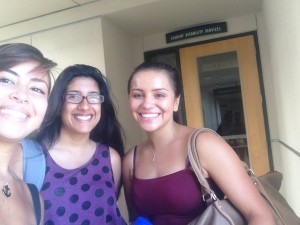 On our way back, we crossed paths with the Calpulli Center and stopped by the Student Disability Services room.
On our way back, we crossed paths with the Calpulli Center and stopped by the Student Disability Services room.
 We then made it to the Student Health Services Administration room.
We then made it to the Student Health Services Administration room.
 We continued our journey to the Office of the Registrar. Our search was very sweaty and tiring… notice our smiles fading.
We continued our journey to the Office of the Registrar. Our search was very sweaty and tiring… notice our smiles fading.
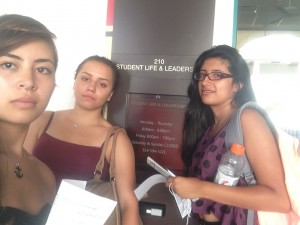 At least the Student Life and Leaders room was pretty easy to find.
At least the Student Life and Leaders room was pretty easy to find.
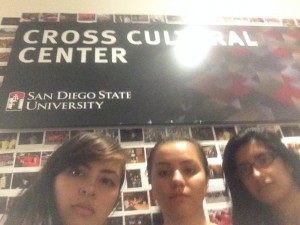 After a couple of hours of searching, manipulation and LIES… we made it to the Cross Cultural Center!!!
After a couple of hours of searching, manipulation and LIES… we made it to the Cross Cultural Center!!!
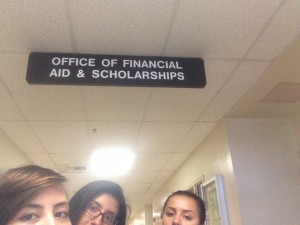 We then had to waddle all the way around the building to the Office of Financial Aid and Scholarships #Turnup
We then had to waddle all the way around the building to the Office of Financial Aid and Scholarships #Turnup
 After failed attempts in the elevator (thank you Kim), we made it to the Testing Center.
After failed attempts in the elevator (thank you Kim), we made it to the Testing Center.
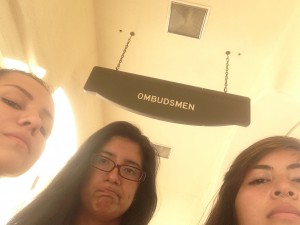 We finally got to this office, but what the heck does OMBUDSMEN mean???
We finally got to this office, but what the heck does OMBUDSMEN mean???
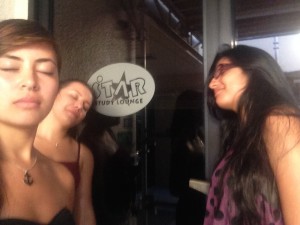 At least our last stop was downstairs from our dorm rooms YAAAAAAAASSSSSS <3
At least our last stop was downstairs from our dorm rooms YAAAAAAAASSSSSS <3
Team Players:
Kiara Grant
Paula Soto
Kimberly Gonzalez
GEN100- Xu and Huang: Scavenger Hunters
We started our scavenger hunt at the Love Library because we assumed that’s where most of the languages would be at. Unfortunately we were very wrong, there were barely any signs in there that were not English. We expected to at least find some signs or posters in Spanish in there, but we didn’t. We then moved onto other campus resources such as the Office of Registrar, Student Life and Leadership, Financial Aid & Scholarships Office, Ombudsman, Student Testing Center and etc. However, those places hardly had any signs or posters in any languages other than English. We did find some brochures and forms in Spanish but that didn’t count as public signage. Then we visited the Cross Cultural Center and hit the jackpot. We found most of our signs and posters of different languages in there. For example we found a huge poster in French in there and a “Si Se Puede” poster from the United Farm Workers motto. In order to prove we went to each location we included little hand drawn pictures of ourselves under most of the signs we took pictures of because we are camera shy.
– By Jia Xu & Xiao Huang GEN100
Morphology of Roy Lichtenstein’s Artwork
- What parts of the image do you see?
1st image: I see a blonde hair woman, tears streaming down a sad woman’s face, a thought bubble, a man in his suit and tie, and a yellow background
2nd image: I see a blonde hair blue eyed woman, tears streaming down a sad woman’s face, a thought bubble, words, and a bed or sofa
3rd image: I see a blonde hair blue eyed woman, a window, a thought bubble, staircase, and words
- How do those parts interact with each other?
1st: Since the man is in the thought bubble, the woman is obviously crying while thinking about him.
2nd: The woman is lying on a bed or sofa crying and thinking about something.
3rd: The woman is sitting beside a window that gazes at the nighttime city thinking about a man.
- Is this image telling a story?
1st: Yes the woman probably thinking about a loved one she’s lost or broke up with
2nd: Yes the woman is crying and thinking about how things should’ve been.
3rd: Yes the woman is wondering about where a man is at, probably a loved one
- Which parts of this image are characters in the story?
1st: The women is character of the story but the man can also be an important character since he’s the cause of the woman’s tears.
2nd: The women is obviously the subject or character of the story
3rd: Just like the previous images, the woman is also the character of the story
- Which parts of this image are crucial for the setting of the story?
1st: Not really a setting except a yellow background but it could probably mean she’s in a brightly lit room.
2nd: There’s not really much of a setting except for the couch/bed the woman is lying on
3rd: The window, night sky and skyscrapers create the background of the picture
- Which parts of this images are crucial for the plot?
1st: The crucial element is the women and the man in the thought bubble because it shows that thinking about the man make her cry.
2nd: The crucial element is the women and the words in the thought bubble because it shows us that she’s crying and regretting something.
3rd: The crucial element is the women and the words in the thought bubble because it shows us that she’s thinking about someone and wondering where he’s at.
- How do these parts interact?
1st: Shows that woman is thinking about a man she loves that has broken her heart
2nd: Shows that a women is lying in bed crying over a relationship probably that should’ve began another way.
3rd: Shows that its late at night woman is probably waiting for her man to come back hoe but he hasn’t come back yet so she’s worried.
- What parts of this image are “root” or “stem” parts and which parts feel like “affixes”? Why?
1st: The root of the image is the woman, the man in the bubble and the tears b/c they are crucial to the plot of the image. The affixes would be the colors, the tiny dots on the characters faces and the bold outlines.
2nd: The woman and her tears are the roots of the image because she’s the main character of the picture and the tears help show the emotion she’s feeling. The words inside her thought bubble is also the stem because it shows us what she’s thinking about that caused her to cry. The affixes would be the bed she’s laying on, the colors and the bold outlines.
3rd: The roots of the image is the woman and the words inside her thought bubble because it shows us that she’s thinking and concerned over someone. The windows, the buildings and the night sky are also the stem because they make up the background and setting of the image. Without it we won’t know that the woman is up late waiting for someone. The affixes would be the staircase, bold outlines, Ben-Day dots and colors because they kind of hold the hold image and brings it together.
- Of the affixes, can you say which are “inflectional” (they only exist to hold the grammar together) and which parts are “derivational” (they add some important information to the meaning, or change the kind of meaning of a given part)?
1st: I think the bold outlines and the Ben-Day dots on the characters faces are derivational. Without them, we’d not be able to see what the image is about because those are what basically make up the picture. The color of the picture however, is inflectional. Without colors, we will still be able to make out the important parts of the image such as the crying woman and the man in the thought bubble. The coloring just adds to the image but doesn’t affect the plot of the image.
2nd: The bold outlines on the picture are derivational because without them, we wouldn’t be able to make out what’s actually in the picture. For example without these black lines we probably won’t be able to tell that’s a woman’s face we’re seeing. Colors again is inflectional it’s just there to tell there to give the audience some extra details such as the woman has blonde hair and blue eyes but those are just minor details not crucial to the plot. The object the woman is laying on also is inflectional, it’s not really part of the background or anything and is just there to give the audience some extra details about the image. Without these inflectional affixes we will still be able to see what the woman is crying about.
3rd: The staircase would be inflectional because it doesn’t really do much to the image doesn’t tell us much about the story of the picture except the woman has a 2 story house. The bold outline, ben-day dots and colors however are what gives meaning to the picture and brings out the plot. The bold outlines and Ben-Day dots are derivational because they’re basically what forms the entire picture, without it we won’t be able to get a clear idea of what the picture is. The colors in this picture unlike the previous pictures are also an important part because the dark blue background outside the window lets us know its nighttime which is crucial for the plot.
10. Find what patterns repeat across the three images you’ve chosen.
All three images revolve around a sad women concerned about romance. In two of them the women are even crying over love. I assume they’re probably the same woman because they all have the same colored hair and in two of the images we can see that both woman have the same colored eyes. They’re probably also troubled for the same reasons by the same man. Another similarity is that the women are always thinking about something, hence the thought bubble. The art style of these images looks like what we’d see in comic books but there are no dialogues at all in these three pictures. The message these images are trying to send out is probably that women think too much and are always troubled by romance because they revolve their lives around men too much. Lastly the artist of these images tend to use the same colors to create these images. He mainly uses colors like yellow, red, blue and white which helps make the images pop out at people even more.
Pictures: Conveying Meaning Through it Parts
The three photos I decided to use all depict a woman. This woman is the root of all the images, for she is the main focal point of the pieces. It is her that is the source of the image in which the viewer emotional connects to the piece.
In the first image, the woman cries as she thinks about a man. At this moment, it is unclear whether they are romantically involved, until you view the other two images. Once viewing the other two pictures, it becomes apparent that the man is her significant other. But the third image creates further confusion, for the woman may no longer love her partner.
In the first image, the thought of the man is an unbound affix. Although he is unbound, he is derivational. This is because, the thought of the man gives significant insight to the emotion the woman is feeling. She is either saddened over him or misses him. The emotion of sadness is conveyed through the way her mouth forms a frown, while in the second image it appears to be a smile conveying a sense of pleasure.
In the second image, the man is an unbound derivational affix as well. This is because, without the man, the viewer would not be able to understand why the woman is crying and an incorrect assumption would most likely be drawn. For the woman is crying due to overwhelming joy, but if the man wasn’t there holding her, she would merely appear sad.
The tears the woman is shedding may be considered an allomorph but I would argue against it, for in the first image they appear to be tears of sorrow. But in the second image I believe the tears are tears of joy. This is because she is reunited with her lover and she is crying because she is so happy that they are together. In either case, the tears are bound affixes for on their own they wouldn’t convey significant meaning, but attached to the woman, the viewer is able to sympathize and understand how the woman feels.
In the last image though, the woman maintains a blank composure. She has a slightly empathetic look on her face, but I feel that is because she is about to break it off with her boyfriend. She says, “I love you, too… But…” This creates a very ominous feeling in the viewer; as if the woman is about to say something she doesn’t want to say but has too. The speech bubble in the third image is an unbound derivational affix, for without it, the piece’s meaning would be unclear to the viewer.
#roylichtenstein #popart #comicart #morphology #visualdissection




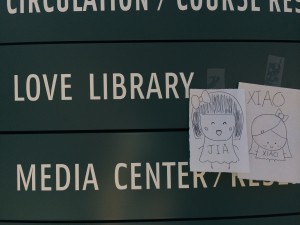
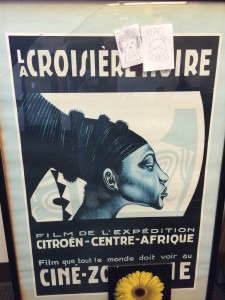
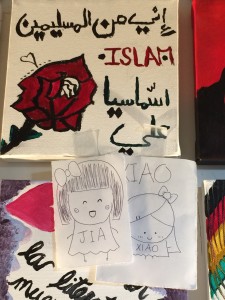

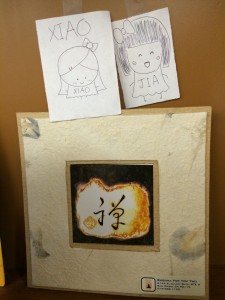

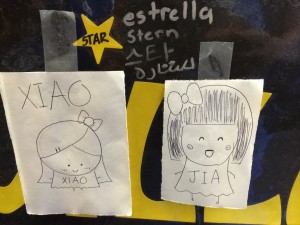
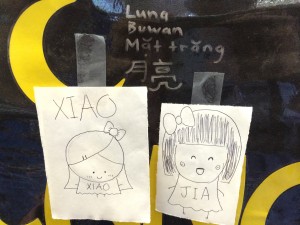




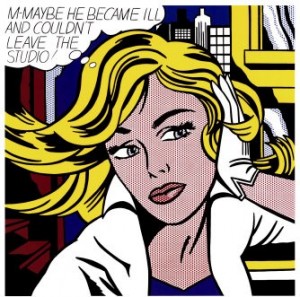


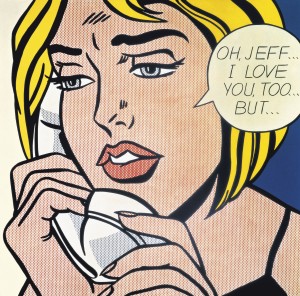
 D5 Creation
D5 Creation